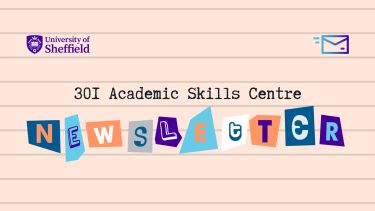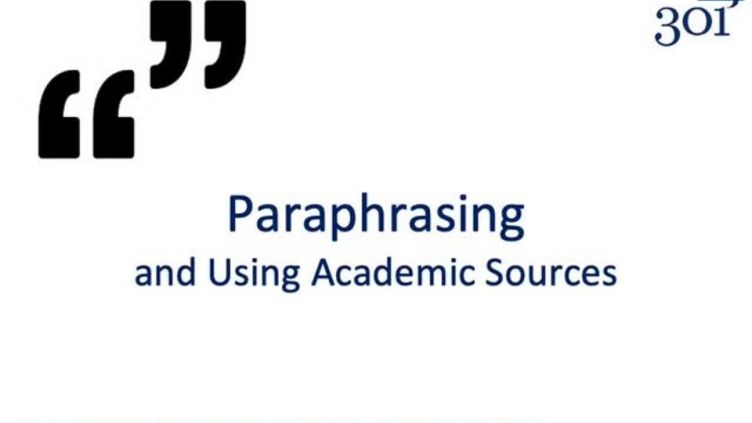Academic writing
Strategies and advice on how to communicate your ideas using an appropriate academic register

Introduction to academic writing
Producing written work as part of a university exam, essay, dissertation or another form of assignment requires an approach to organisation, structure, voice and use of language that differs from other forms of writing and communication.
Academic writing is a language that no one is born speaking. Understanding more about the conventions of your discipline and the specific features and conventions of academic writing can help you develop confidence and make improvements to your written work.
Academic writing is part of a complex process of finding, analysing and evaluating information, planning, structuring, editing and proofreading your work, and reflecting on feedback that underpins written assessment at university.
Here we focus on the key principles of academic writing as a way to communicate your ideas using appropriate language, structure and organisation.
301 Recommends:
Our Academic Writing Essentials workshop will explore the challenges of writing in an academic register and provide a range of strategies that can be used to develop your academic voice. The workshop will cover the use of language, structuring your writing and critical writing to take a holistic view of the writing process from a blank page through to a completed piece of work.
Try out our Academic Writing Interactive Digital Workshop to explore the key principles of good academic writing.
Our Paraphrasing workshop will explore the roles of paraphrasing, quoting and 'para-quoting' and provide strategies for formulating and referencing paraphrases.
Join our 301 Writing Club sessions which include three 25-minute blocks of silent writing time, plus time to share your writing goals and progress with others. This is not a workshop, please bring an piece of academic writing to work on.
Academic language
Academic writing is defined by conventions rather than rules. This means that they are flexible and adaptable at least some of the time.
The point is not for you and your peers to produce identical pieces of work, but to provide a shared framework of communication that allows specialists within a field to access information, ideas and concepts quickly and easily.
It goes without saying that academic writing uses a more formal register than everyday communication. The following are four important conventions to follow that will help you to hit the right level of formality in your writing:
Use formal language
Academic writing tends to adopt formal language derived from Latinate, rather than Anglo-Saxon roots. This distinction is particularly evident in the use of verbs in academic language.
In general, phrasal verbs are used when speaking (eg in presentations), whilst Latinate verbs are used in academic writing (eg essays). Phrasal language is more informal, whilst Latinate verbs sound 'posher' and more formal.
Phrasal verbs tend to come in two parts: they use a verb together with an adverb or preposition.
There is often a one-word equivalent, which usually comes from Latin root, reflecting the origins of formal English among educated Romans and the Church.
Examples include:
-
Carry out = perform
-
Talk about = discuss
-
Look up to = respect
Why is this useful? Latinate verbs use fewer words, so can help you develop a more concise writing style.
Latinate verbs can also be more specific than their phrasal equivalents, for example, the phrasal verb 'set up' has several Latinate equivalents:
-
Set up a room: I’m going to arrange the room for the meeting.
-
Set up an experiment: The experiment was prepared.
-
Set up an organisation: The NSPCC was established in 1884.
You may wish to use a mixture of phrasal and Latinate verbs in your writing, and to tailor it to your assignment. For example, if writing a more informal blog post, you may want to use more phrasal language.
Some common examples of academic verb use include:
-
Carry out: Perform "The experiment was carried out/performed..."
-
Find out: Investigate "The aim of this project is to find out/investigate…"
-
Leave out: Omit "Therefore this was left out of/omitted from the analysis..."
Awareness of how and when to use different registers of language can help to improve the level of formality of your writing.
Avoid contractions and abbreviations
Academic writing tends to avoid the types of contractions and abbreviated language that you might use in other forms of communication.
In some cases, this is obvious, but in other cases, where abbreviations have become commonly used forms of words, it can be more difficult to spot.
For example:
-
Are not/is not: Aren't/isn't
-
Quotation: Quote
-
UK: United Kingdom
However, some commonly used abbreviations or acronyms relating to the discipline will often need to be used to enhance the clarity of your writing and reduce the word count.
In these cases, it is important to use the full form of the abbreviated name or phrase in the first instance, including the abbreviation in parentheses.
For example:
-
A key role has always been played by the North Atlantic Treaty Organisation (NATO)...
-
World Health Organisation (WHO) recommendations state...
-
The use of an Electrocardiogram (ECG) is recommended...
Certain extremely commonly used acronyms have become part of common usage and do not require further explanation within a text. For example, AIDS, laser, radar, scuba.
Write objectively
Academic writing tends to strive for an appearance of objectivity.
Although you will no doubt have an informed opinion or theory that you are trying to get across in your writing, it is important to build a compelling objective case for your ideas using evidence and data.
Secondary sources should be used to build a foundation of background thinking, ideas and theories to support your approach.
All secondary sources (books, journals, webpages, conference presentations, films, audio recordings, etc.) should be referenced using the standard system recommended by your department.
A bibliography of all referenced works should be included at the end of your assignment, ordered alphabetically and formatted using the recommended standard system.
Visit the library referencing pages for more information, examples and tutorials.
Primary sources include any information or data that you have found, collected or generated to illustrate your arguments or explore your hypotheses. Primary sources may include texts that you are analysing, survey responses, experimental data, artefacts and much more.
When writing about primary and secondary sources, it is usually better to avoid using the first person ('I' or 'we' forms), as your focus should be on an objective interpretation of that evidence.
The first person is most commonly used to indicate where you are going beyond an objective analysis to put forward your own informed opinions, for example as part of a discussion section or conclusion.
Some principles of using the first person include:
-
Avoid overusing the first person (I) and use passive forms where possible: "the experiment was conducted..."; "evidence suggests..."; "a sample was taken..."
-
Watch out for adjectives that imply a value judgement: fantastic, brilliant, rubbish, interesting, good, etc.
-
Avoid using cliched phrases: "a hot topic..."; "the other side of the coin..."; "at the end of the day..."; "the fact of the matter..."; "in the current climate..."
-
Avoid overstatement. Make cautious use or avoid the following altogether: extremely, very, really, always, never, a lot, the most, the least
Note: always check department guidelines on the use of first-person forms in your writing.
301 Recommends: Manchester University Academic Phrasebank
The Academic Phrasebank is a repository of the most commonly-used phrases in published academic work, organised according to purpose and function. Explore the Phrasebank for ideas on how to express yourself using established academic language.
Paragraphs and flow
Paragraphs are the building blocks of your written work, and a good essay or assignment will organise the content clearly at a paragraph level.
However, in a piece of academic writing paragraphs can be tricky to structure due to the complexity of ideas that you are likely to be working with.
The following structure is not the only way to write a paragraph, but it is a common model that is used in academic writing to build sources and evidence into your writing in a critical and analytical way.
Writing good paragraphs: structure
Most paragraphs of academic writing tend to follow a similar organisational structure:
-
The topic sentence: States the main idea or area to be covered by the paragraph.
-
Explanation or definitions (optional): Can be used to clarify any difficult or uncertain terminology introduced in the topic sentence.
-
Evidence and examples: One or more sentences introducing key ideas, sources, quotes, case studies, evidence or data.
-
Comment: Explores what the evidence means, how it can be summarised or whether it needs to be challenged.
-
Concluding sentence: Relates the paragraph to your overall argument and links forward to the next paragraph.
The final sentence is often the most important part of a paragraph as it clarifies your interpretation of the topic area and identifies how it contributes to your overall argument.
Watch this short study skills hacks video for more information.
Writing good paragraphs: unity
A paragraph will usually discuss only one idea as outlined in the first sentence, the topic sentence. If you find a paragraph drifting away from this controlling idea, it is time to split it into more than one paragraph:
-
The opening sentence of paragraph should outline the main idea (topic sentence).
-
Every supporting sentence should directly explain, refer back to, or build on the main idea using specific evidence and examples where possible.
-
Use the final sentence(s) to refer back to the topic sentence and lead into the following paragraph.
Writing good paragraphs: flow
The skill of structuring your writing and building effective connections between paragraphs is one that will allow you to develop and sustain a compelling argument in your written work.
By setting out your ideas and evidence with a natural flow, you will make your work much more readable.
This important technique will help you work towards higher levels of attainment in assignments and help to improve the quality of your everyday writing.
Paraphrasing and quoting
When you are producing a piece of writing at university, you will often want to talk about what someone else has written about the topic.
There are four distinct ways of doing this.
-
Quoting: directly including in your work the published words or other data you have found in a source
-
Paraphrasing: expressing in your own words the ideas, arguments, words or other material you have found published elsewhere
-
Para-quoting: paraphrasing an idea or area but retaining one or more important words and phrases from the original in quotation marks
-
Summarising: providing a top-level overview of a single larger area of work or multiple sources
There are many reasons for quoting or paraphrasing in your own work, but essentially these techniques allow you to show your understanding of current knowledge about the topic you are studying and respond to that knowledge in your work.
Remember that you will need to cite and reference all of the sources that have informed your work.
It is a complex linguistic skill to incorporate others’ work smoothly and efficiently into your own by quoting or paraphrasing.
Skilful use of sources and selective quoting and paraphrasing are important elements of the critical writing process, which is in greater detail on the critical thinking pages – see Legitimation Code Theory for more ideas.
It is also a key skill of academic writing that will help to ensure that your work does not include elements of plagiarism.
For more information on unfair means and plagiarism, including suggestions on how to avoid it, see the following resource.
As with other aspects of working with sources, it is important to follow your department's specific guidelines about these skills.
When to quote and when to paraphrase
You should direct quote
-
if you are referring to a formal definition in which the specific language is important
-
if you are quoting an opinion (with which you do not necessarily agree)
-
if you are reporting direct speech, eg the reactions or experience of someone actually involved
-
if you wish to highlight specific features of the author's writing style
You should paraphrase
-
to elaborate on or explain a concept or definition to your reader
-
to engage critically with an opinion or source and demonstrate that you understand it fully
-
to summarise the reactions or experience of one or more individual
-
if the general concept is more important than the specific language used
Writing to a word count
If you find you often go over the word count on an assignment, there are several possible causes and solutions.
In this online resource, we will think about the purpose of the word count, the reasons why we might go over it, and strategies to tackle it.
Why is there a word count?
Word counts are part of the challenge of academic writing for several reasons:
-
To suggest a level of detail: with one topic, you could write a 100-word summary, 1,000-word essay, 10,000-word dissertation, or a 100,000 word PhD thesis. The word count gives an indication of the level of depth you are expected to go into
-
To ensure fairness: each student has the same number of words to show the marker what they know.
-
To test your communication skills: being able to keep within a word count requires a concise writing style and excellent communication skills – it helps you get straight to the point.
-
To demonstrate your critical thinking skills: to stay within word counts, you need to focus on what is most important and select the best examples and case studies. It puts critical thinking into practice
-
As a matter of practicality: markers only have a finite amount of time to mark work.
Why do we go over the word count?
First of all, it is important to remember that being over the word count is better than having a blank page. The ideas are down on the page but might need refining. There are several reasons why you might have exceeded the word count:
-
Still developing an effective structure: Do you have a clear plan and have you stuck to it? If not, can you map out an overall structure for your essay and identify areas where you have departed from it?
-
Fear of missing out on something important: try to be selective with examples and arguments. What is your mission statement or key argument, and how does each section help you make it?
-
Waffling (using 200 words when 100 will do): work on developing a concise academic writing style. Even if you’re not over the word count, this leaves you more words for your critical analysis and discussion
Writing to a word count
Writing to a word count involves careful planning and organisation to make sure that you get your main points across. The following points might help you to stay within the parameters that you are aiming for:
- Plan what your key points are, and what percentage of your word count to spend on each. Are any sections disproportionately long?
- Avoid repeating arguments – try reading your work backwards (paragraph by paragraph, not word by word). This can make it easier to spot ideas that are repeated, as you are viewing each paragraph individually rather than your argument as a whole
- Use topic sentences at the start of each paragraph. This can help you (and the marker) to identify what key point you are trying to make. Are there any paragraphs that are making the same point? Can you link them?
- It might be tempting to show all of the reading you have done, but select the most important case studies, and explain why you have chosen them. This can be evidence of critical thinking (eg whilst many studies have examined X, a key paper is Y because…)
- Are you using 200 words where 100 will do? One way of testing this is to calculate your Fog Index to find out how clear and concise your writing is.
Remember: Having a more concise academic writing style gives you more words to use on things that are important, eg critical analysis and discussion. It’s not just about cutting the odd word here and there to get you under the word count.
The following are some simple tips to make sure you stay within your word count:
Dos
-
Find out what counts towards your word count (for references, footnotes, abstract, captions, tables, text boxes…)
-
Consider combining related sections or cutting irrelevant sections.
-
Focus on condensing your key arguments.
-
Use a concise academic writing style, eg avoid excessive hedging, remove redundant adjectives.
Don'ts
-
Lie about your word count.
-
Cut sections just to meet the word count.
-
Focus on removing individual words – this will be extremely time consuming and will make little impact on your overall count.
-
Use contractions to meet the word count (eg isn't, doesn't, shouldn't) – this is not academic.
Useful resources
Internal Resources
University of Sheffield Library – Research and Critical Thinking Resources
Digital Learning - Using Turnitin (login required)
English Language Teaching Centre (ELTC) – Paraphrasing
External Resources
Manchester University – Academic phrasebank
UCL Institute of English – Word count
Gunning Fog Index Calculator – Online tool
Purdue Online Writing Lab – Quoting, paraphrasing and summarising
Wisconsin Writing Centre – Paraphrasing vs. quoting
Using English for academic purposes – Writing paragraphs

Be the first to hear about our new and upcoming workshops!
The 301 Academic Skills Centre newsletter is a fortnightly email for study skills, mathematics and statistics.
Be the first to find out about our:
- new and upcoming workshops,
- special events and programmes, and
- new and relevant online materials and resources.

